When we walk the path of spirituality, it’s actually an individualistic journey. You can’t really define that this path should be like this, in a particular way. But I would like to look at the spiritual journey in a logical way, so that it’s easy to understand.
The journey can be classified broadly as a formation stage and stabilization stage; not the accomplished stage.
What is the formation stage?
Formation stage is the toughest because we are a bundle of patterns and we have a lot of habits. We have a lot of fears, habits, likes and dislikes, so many different things. We have to detach from this whole jungle or the variety of things that we consist of because most of this is connected to the world outside. This is our dependency to the world outside, it could be places, it could be materials, and it could be relationships; so many things connected to the world outside.
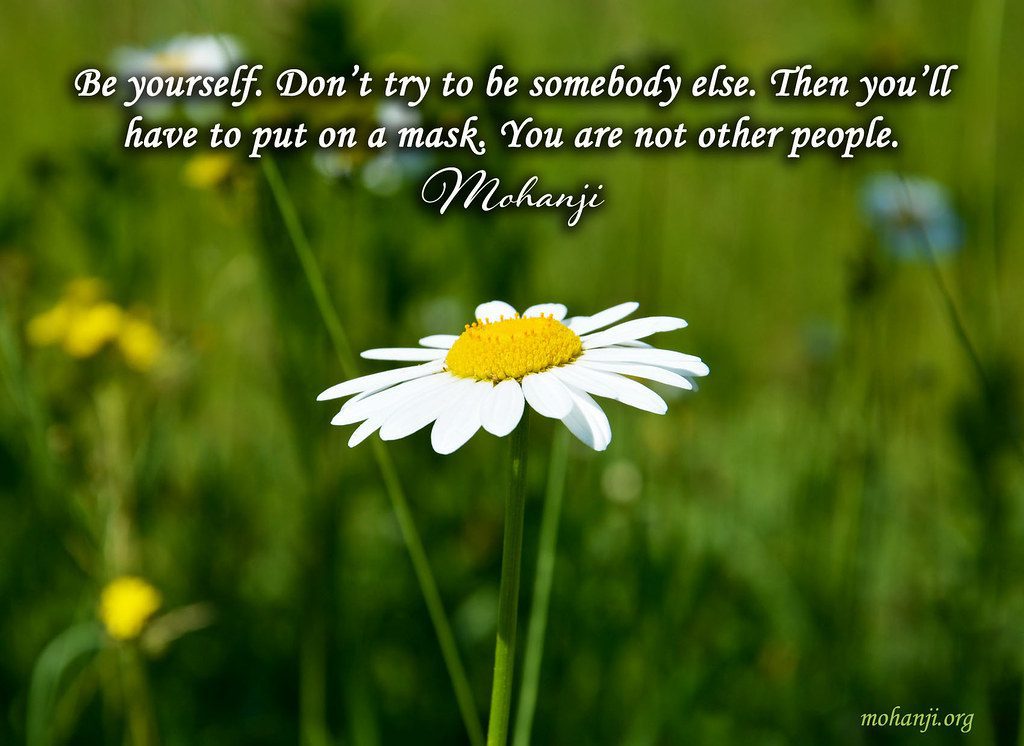
So, to detach from all that and come inside, it takes a lot of effort. So that’s the most difficult thing in the path of spirituality. Spiritual journey is basically BEING YOURSELF. Finally, what you’re going to be is be yourself totally. So, in that journey, the first part has a lot of value. Once that’s crossed, it’s easier; but to cross that first path, to detach yourself from habits, your usual patterns, your usual likes and dislikes, all the things connected to the patterns, to come out of it, it takes great determination – more than determination, discipline.
These two Ds you should remember; discipline is essential.
I used to get up at 2:30 am every day. I would start from three o’clock every day, whatever happens, whether it is sun, rain, cloud, whatever, it didn’t matter. I used to get up at 2:30, I used to take a bath and always without taking bath, I never used to indulge, as that’s a part of discipline. Why take a bath? Water refreshes you immediately and just removes the tedium and the TAMAS which tries to overpower you in your sadhana, in your practice; immediately that’s cut, water takes it away.
So, with the help of water, with the help of a determined mind, you start your journey. You start your journey means you start your practice.
That should be very consistent; big time determination.
With determination also, sometimes you don’t even know what you’re looking for. This is the big problem. So, the usual, the known things always attracts you back. By known things means what you’re familiar with; what you’re familiar with, always takes you back. That’s usually the case. We tend to go back and then we lose the track. This is why a time of isolation has a lot of value. In this time of forced isolation, you can’t go anywhere. Otherwise, you have a lot of options. When you have a lot of options; when you have a lot of means and avenues for fulfilment; all that’s distraction.
So, the enemy is distraction, one D; and your ally is determination and discipline – 2Ds. So, these 2Ds are very important.
D and D – two pillars; and that will be the main thing in the formation stage – formation time. So, in the formation stage, this is what we must remember – 2Ds, our friends; DISCIPLINE and DETERMINATION. Distractions are like shadows behind you; it connects itself to habits and patterns. So, patterns and habits are your comfort zones; the zones of comfort that attracts you back.
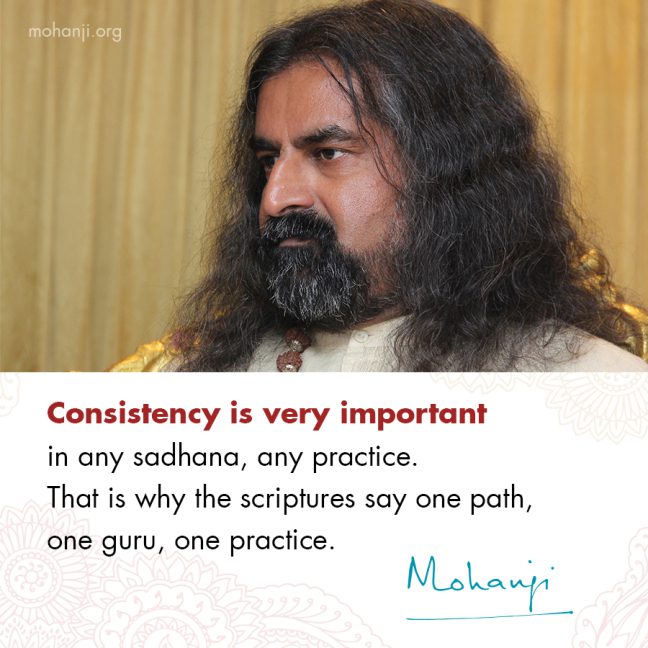
So, take one sadhana, one practice; it’s very important, maybe one mantra, one practice, one discipline.
One discipline means one method like a particular time or a consistent space, is very important. We must be in one space continuously because if we change the space, the mind likes it. That’s a distraction. Do not change the space, stick to the same space as it takes months and years probably since the patterns are so strong; don’t underestimate them. They keep coming back, or they keep reclaiming their position in your life. So, what you need to do is to be consistent, very, very consistent.
Always remember, when you’re using a mantra that mantra should be learnt by heart. You should not read from somewhere because if you have a picture, mind wanders over pictures. If you read a book, mind gets occupied with the book. See, don’t underestimate your mind. It really distracts you. So to avoid all distractions, get into immediate action, avoid thoughts. When you get up in the morning, immediately get on with your action.
You should have a discipline and don’t change the discipline because even if you change the discipline, mind occupies that because mind gets involved. So today, I brushed my teeth first, and then I went to the toilet etc., don’t jumble these kinds of things, just follow the same routine. That will help you because you contain things within the time; you’re not crossing your time limit. Then one thing that is very important is to only chant or only do things which you’re familiar with. If you’re not familiar with a mantra, don’t even try until you become familiar with it. I’m talking about sadhana, for practice. Otherwise you can chant any mantra you want for the rest of the day. During the practice, use only a familiar mantra. If Guru has given a mantra, that’s the best for you because the Guru knows what is good for your alignment.
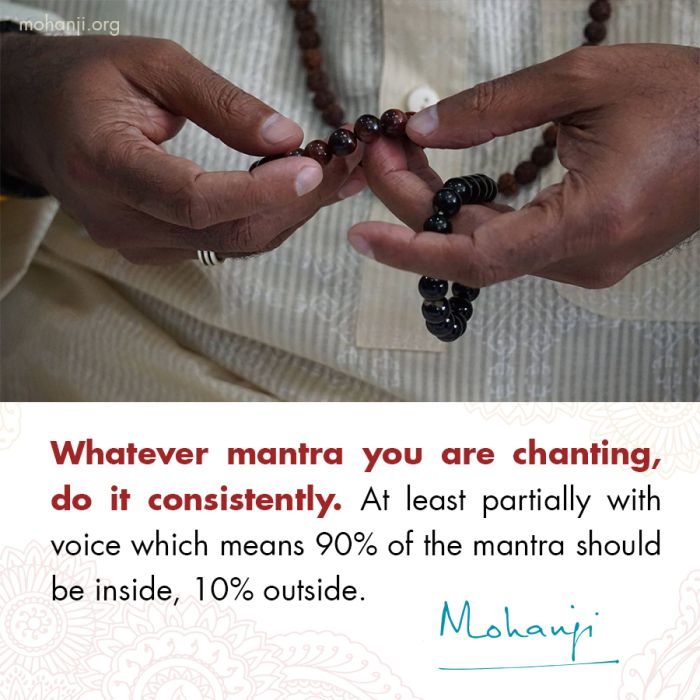
So, chant that and chant continuously, consistently and feel and chant. That way, you are chanting 90% inside you, and 10% outside. So that means you’re chanting outside because you don’t fall asleep; you are chanting inside and you’re feeling the vibration. The outside world is exists; but you’re not looking at the outside world. After chanting for some time, you can go to that state. If you’re doing pranayama, you connect to the light of the lamp. I used to have a lamp lit. Have only a lamp, just a flame. Look at the flame for some time, connect to the flame and chant to the flame and then you chant inside and then you bring yourself inside. You can practice like that. So many different practices have been explained already.
I don’t want to say about that again, because it’s already there. We have meditations and practices; kriyas. In case you are feeling a bit sleepy and drowsy, breathe through one nostril, close one nostril, breathe through the other nostril to the count of six to 8; one count – either six or eight. Then close that nostril and breathe out double (16 counts); if it is 8, it is 16; if it is 6, it is 12 and then breathe through the same nostril, again, six or eight and then release through the other nostril, double. Do that for about 10 times and you will come back and you can actually start it again. So, discipline is very important and this should be very consistent. Whatever happens in the world, whatever the external factors are, we must not stop that.

One of the basic practices which all of us should follow in this world of distraction, to get back is the presence of mind. Make sure that nothing happens without your mind being present. That’s a very good practice. That should be a daily practice; when you’re in your waking state, all the time. Even if you’re moving your hand, let your mind be there. If you’re speaking something, let the mind be there. If you’re eating, let the mind be with the food, with the taste. If you’re doing anything, thinking anything, talking anything, let the mind be present. Without the presence of mind, do not do anything. That’s a very good practice. If you can do that consistently, then you will feel a lot of stability. There’ll be no waste of energy, there will be no excesses. There’ll be no mistakes, there’ll be no disappointments, and you will be feeling very stable. Presence of mind is a good practice and that helps your other practices. Once this discipline starts, (discipline means the order of your activity), let’s say, getting up early in the morning, having the same space, same practice, same mantra, same connection, all those things should be the same; this will actually increase your boredom because you will want variety, you will crave for variety. That is the mind’s job, mind wants variety. But what you want – to cut across the mind and reach a state of accomplishment. So, here, the mind will try to bring you back to a pattern while you are refusing to be in a pattern while making a pattern. This is the point here; making a pattern means same mantra, same practice, consistently. Boredom hits you, continue again and again and again, no change and then finally, mind withers away. It takes time, but mind will break. So the formation stage then shifts to stabilization stage. The formation stage, I have already explained discipline and determination; enemy is distraction. Consistency is very important. Along with consistency is the routine, all those things. So, conviction is extraordinarily important. Imagine if your conviction on something is proved to be wrong later. It doesn’t matter. Because it’s not the object you’re connected to. It’s your method, your conviction that’s helping you.
So don’t look at any outside material, person, place and think that this is what is helping you; they do complement, but it’s you, who’s helping yourself. And finally, you’re reaching yourself. So the journey is to yourself, and the path is yourself. And the practitioner is yourself. And it’s all yourself. Basically, it’s your own journey to yourself, in which all external factors have no deep value that way. So, don’t blame an external factor and say, “Oh, because of that factor, I couldn’t accomplish.” That’s not true. That’s because your determination failed. Later on, once you cross over to the stabilization state etc., you don’t have to follow those and sometimes those things you can’t follow because the practices are completely wiped away or vanishes; those practices will not stay because you reached a state where you are that state. It’s almost like studying hard for graduation and you became a graduate, you don’t have to study all of them again, because you’re done. So, once you reach a state of accomplishment, you don’t actually go back to your practices.
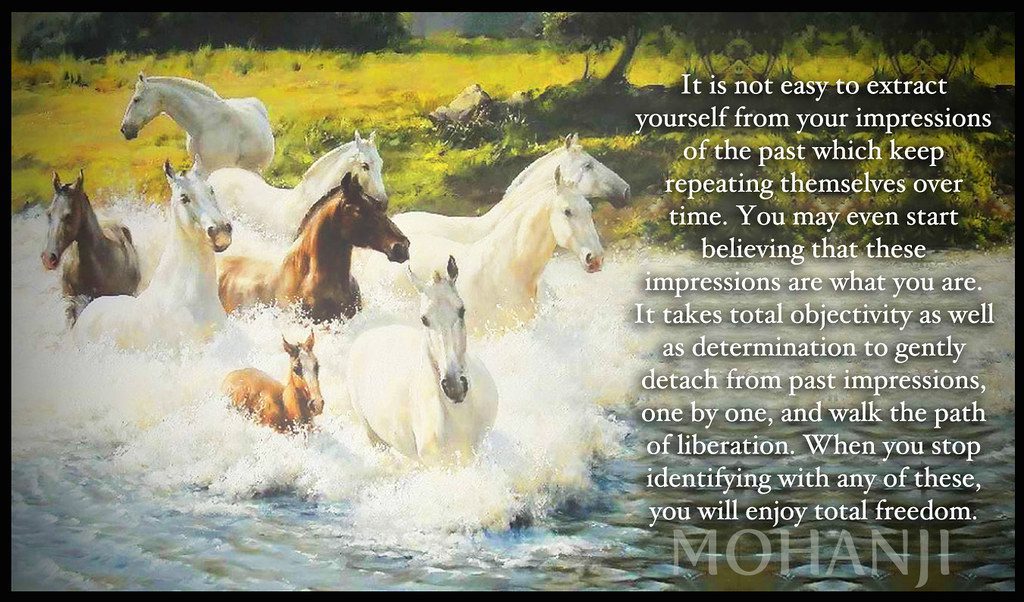
Next is the stabilization stage. Once this stage is over, you are in a path of stabilization. How do you know whether you are stabilizing? Distraction level will be less, whatever happens you’re peaceful, you’re calm; external environment or environment around you does not affect you or it cannot affect your equilibrium. That’s your stabilization time. At that time, what you need is consistent practice; you have to continue with the practice. Don’t stop. At the same time, you also should practice witness hood which means you are witnessing yourself practicing. That’s the stabilization stage. You witness yourself doing all this. So, there is an impersonal feeling there. You are not that but at the same time you are doing it. You are not fighting your mind at that time. That’s finished. That part is over. When your distraction level has reduced and nothing distracts you any more, then you automatically understand that you are on the stabilization time. So, it is a settlement time. Slowly, slowly you are settled. And the more and more you settle, the deeper and deeper you go. The deeper and deeper you go, more and more silence settles. So when you go deeper and deeper, noises reduce. It’s like from a heavy world of noise or world of heavy noises, you’re withdrawing and you’re going to a world of silence. For some time, the noises will be there. Again, you’re going and you’re determined to go to the world of silence. And after a while, when you are closer to silence, you will hear the noises far away; it’s not even near you. And when you enter the world of silence, then the noises completely stop. So, this is the journey. So, stabilization is that you are actually far away from noises. And to go back to those noises, you have to walk all the way back which you may not because that stage is over. Initially, you will tend to go back to your old habits of noises (noises means activities, various things).
So, when you are in a stabilization mode, you need to witness yourself. You will watch yourself because there’s nothing distracting you. No distraction. You watch yourself. You feel yourself and you feel yourself entering into the world of silence. At stabilisation time, you must continue the activity. But at the same time, you realize you’re not the activity, you are the product of all these, but you are not any of these. So, that means your level of detachment has really increased. Activities do not bind you, nor do the results bind you. Nothing binds you. You are really free. Real freedom you start experiencing at that time. No dependency on people, places, time, materials, any habits, any patterns; that in itself is freedom; huge freedom. That is when you realise this is the real freedom; this is what we are capable of. Why have we never understood it? We have never tried it; we never invested in ourselves that is why we didn’t experience it. Here you are investing in yourself.

So, one of the things which will come overwhelmingly in you is the gratitude; gratitude to the guru, the guide, the one who guides you, the one who actually guided you to the silence, you’ll have immense gratitude. That is the secret of Guru Parampara, where the disciple is overwhelmingly grateful to the guru, but that gratefulness is sometimes not visible in this world, the world of noises is because this gratitude is from the mind; mind cannot hold anything. Mind never holds it. Mind keeps it for some time, throws it away; sometimes picks it up, sometimes throws it away. So, mind is never consistent. We will never understand gratefulness from the terms of mind, until we go into silence. Then we know that this position, this place we have reached is because of the grace of the gurus; then you will be brimming with gratitude, which opens up grace further. So the last part where you are almost entering into silence, overwhelming grace comes to you because of your overwhelming, real gratitude. Real gratitude is not from the mind. It’s gratitude, because you understood that it’s the guru who brought it. That’s why the shloka says, the verse says that if Guru and God come together, who will you bow down to? So the answer is to the Guru, because he showed me God.
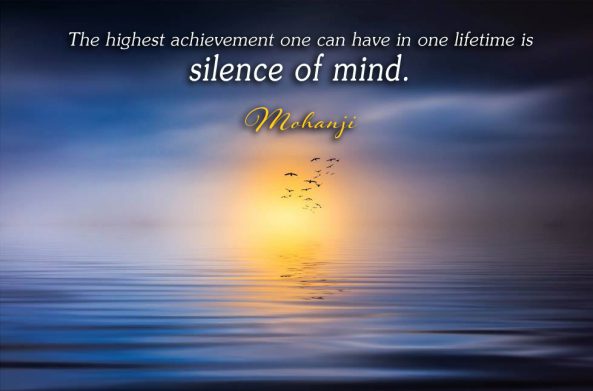
So this happens, and then you enter the silence and you’re stable. That means you’re settled down into yourself, and the outside world is not yours anymore. You can go to the outside world, you can interact with outside world, you can be anything in the outside world, there’s no problem. But you are not the outside world. You don’t belong there. Now, you’re going back to the outside world as silence. Earlier, you were going to the outside world as a noise, another noise, but now you’re going to the world of noises as silence. The difference is very big. You are entering the world of noises as another noise. Then you are insignificant. But when you enter the world of noises as silence, you become very significant. This is a very tricky time because you are different. By different it means people look at you through their eyes in different ways, as they are. Some of them look at you as an alien, what sort of an animal is this?
Some of them look at you as a challenge. Some of them don’t even understand you and they ignore you. That’s okay. But everybody looks at you as they are and then it will be confusing to you. What is the best thing to do? Allow everything to happen. Let everything happen. You’re not worried. Let everything happen; somebody loves you, somebody hates you, somebody criticizes you, somebody praises you, it doesn’t matter. It’s all fine. Everything is fine. You are not bound by them because you are fully settled inside. The world of noises does not shake you anymore. It can’t, then it’s a living accomplishment, then you are living in an accomplished state (accomplished state means state of silence). The living accomplishment is just beingness; there’s nothing else, there’s no doingness there. Even if there is doingness, that is only for the purpose or for the purpose of your existence. As long as you exist, you have to deliver and for that sake, you will deliver and what will you deliver? What is needed to be delivered! It’s a case to case, situation to situation. It’s not a pre-planned delivery method as it happens in the world of noises. So in the world of silence, there is nothing to do, it’s only to be.
So, in that mode, when it’s only To BE, when somebody comes to you, you look at why this association, this relationship or this meeting happened and you just deliver what you have to deliver. But you will not be worried about, “Oh, will I be able to deliver?” because there’s no ‘I’; why this person came to me, there’s no ‘why’. So, there’s no ‘why’, there’s no ‘I’. It’s very simple. You give what you have. And that’s what’s expected. And there’s no pretension. There’s nothing to pre-plan. There is nothing to prove. That’s the world. So, the third state – the state of accomplishment, you don’t need any guidance because you automatically do what it takes, what you need to do.
These are the three stages. The first is the formation state where you need a lot of discipline, determination; to avoid all distractions. Then comes the world of stability – stable world, where you need to witness; you need a lot more witness hood, activity plus witness hood. Then, you reach a stage of accomplishment which means you’re accomplished. In that state, what you need to do is just be you. So being you is what the ultimate is. Being Yourself. And that’s the journey.
All the 7.5 billion people of the world have the same potential to achieve it. And the one who is capable of doing MANANA is a Manav; that means one who is able to contemplate is a man. Manana has something to do with Manav which is a Sanskrit word, and also man, an English word. It’s all connected with Manana which means somebody who’s able to contemplate, penetrate, understand, assimilate and experience themselves. It’s not experiencing the world outside. That’s easy because all you need is senses and mind. That’s nothing; that’s just a normal thing. But experiencing yourself, that capacity we have; that is something which we can achieve in a lifetime. And that is something which we must achieve in a lifetime because that’s the real thing. The world of noises, world of materials, world of sounds and colours are fleeting. They are available only when you are awake. That’s not available all the time. When you’re sleeping, they’re not available, but here we are talking about a world which is available for you all the time; same world, same brightness, same freedom, all the time. That world is worth it. That’s exactly what is the highest of human experience.
We can call it self-realization, we can call it God-realization; doesn’t matter what you call, but in the world of being you, you are experiencing yourself all the time. Whether you are awake, whether you’re sleeping, whether you’re dreaming doesn’t matter, you are experiencing yourself. And that world is very, very powerful. From that world, you actually experience the Creator. When you start experiencing the Creator from inside, all the time you experience being the Creator. Then you have no separation with anything on Earth because the Creator and the Creation are one and the same. All the things you see around are the creations; all the materials, all the moving, immovable things, all the things are creations. In every creation, there is an element of the Creator and we start witnessing that creator within us and outside us. Then, we can’t have a separation. There’s no separation, there’s no me and mine. There’s no ownership. There is no possessiveness; there is no need to control anything. There’s nothing to control. So, once you understand the mind of the Creator, you become the Creator. You and the Creator are one. And then, it’s dissolution. That’s a state of dissolution. Once that awareness settles in, then you dissolve, then there is no you and that state is beautiful, perfect. The state of being the Creator, the creation has become the Creator. The dancer has become the dance, then there is no separation, then there is no division. When the song and the singer become one and the same, you’re fully melted. You are one with the whole creation.
So from the world of noises to the world of silence, it’s a consistent walk. It’s worth it. All the masters have said the same thing, over and over again. Many of them have seen it. Many of them have witnessed it. Many of them have become that. And those who have become that never came back to the world of noises. Those who witnessed it tried again and again, and they try to go back to this state of peace; perpetual peace all the time. Many of them did. But those who have knowledge and they are teaching, they are still in the world of noises. So, that difference is there always. They might have learnt a lot of things; the books, the materials, so many things they would have learnt and they understand. Understanding and experiencing are two different things. You understand how to make a very tasty dish. But to know how it will taste, you have to eat it. And once you taste it, maybe you won’t be able to explain about it because it’s not explainable. Some things are not explainable. You have to experience it, and just allow that experience to settle into you, you become the experience. But you can’t explain. What you can explain are the noises and the expressions.
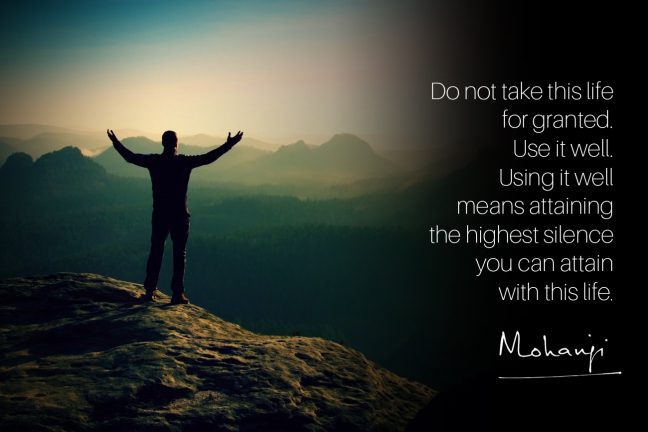
So many people who have attained silence never spoke, because there was nothing to speak. Speaking was very difficult, because the world of noises is a gross world when you have reached a level of subtlety. It’s almost like you don’t have a body, how will you communicate, how will you act? How will you touch? How will you feel? How will you experience the world as a body? So it’s like that. Imagine that your level of subtlety is high. When you’re completely subtle and your body is just an attachment to your system, and you don’t really feel the body; in that mode, when another person comes to talk to you, you become that person; you will express that level of grossness as much as you need to express or communicate to that person. If a very subtle person comes to you, you become that subtlety because you are very flexible. You are not bound by the world of noises. The world of silence is huge flexibility; totally flexible. You don’t have to think that “Oh, this man is coming now, how I will respond?” There’s nothing to think. You’re put in a position, words flow through you as per the need, as per the requirement of the person or the society or the environment or the time. That just happens; you don’t have to really do anything.
So, I think I have explained the three major aspects of the path of awakening and this has to be assimilated. You should listen to it many times and feel these words; not just listen to these words, actually feel these words. So you will understand the formations, how important is the formation. That’s the most important stage because you are actually destroying your patterns at that stage. It’s not easy; it’s not easy at all. Don’t underestimate that time; don’t underestimate your patterns. Don’t underestimate your habits, your inclinations and tendencies, your desires. Don’t underestimate them. They’re very powerful. They can literally turn you around, and they can literally keep you as a slave to it.
Usually, we are not slaves, but these things make us slaves, dependent on the world outside. We are behaving like slaves, helpless; we don’t have to be helpless. We don’t have to be. We should know that we are the depth of silence. We are powerful, very powerful. Only if you could experience that power, you will know. Otherwise it’s just an idea or a theory. You wouldn’t even know. When you experience, when you establish yourself in the world of silence, deeply in the world of silence, then you are a God-man. You’re one with the God; one with the Creator. You are a God-man. Until then you do not understand a God-man. Who’s a God-man? He looks like a man; human being. How can he be God? What is his state makes him that. His state, his stature makes him godlike. God is not one unit. God is omnipresent. God is universal and God has no boundaries. So when a person loses his boundaries, he becomes universal. He is a God-man. So God-men do exist!
Mohanji
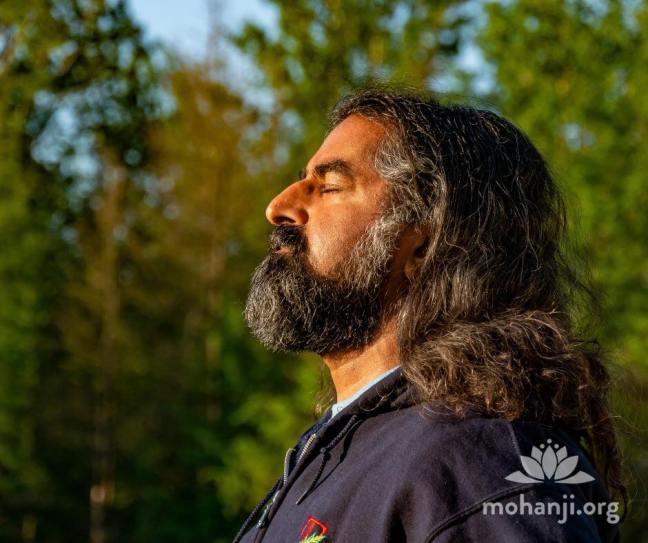
Transcribed and proofread by
Rekha Murali
Read or watch other Mohanji’s messages on Corona virus here.
How to add subtitles:
On a mobile:
Click the three dots at the top right corner, choose Captions – English (or other available language)
On a computer:
Click on a setting icon at the bottom right corner, choose Captions – English (or other available language)

3 thoughts on “How to walk the path of spirituality”
Pingback: Mohanji on his Journey – Thus Spake Mohanji
Pingback: Kako koračati putem duhovnosti -
I want to start my spiritual journey.yet my mind is clean and clear from any bais about spirituality. Absolutely I don’t know what is spirituality.I need one Guru who will guide me correct and with right perspective and perfect way..direction
No chance for misguide,confusion ,time wasting .Iam ready,let see what happen.
I read complete blog..I feel I will get what I want exactly .thank you.